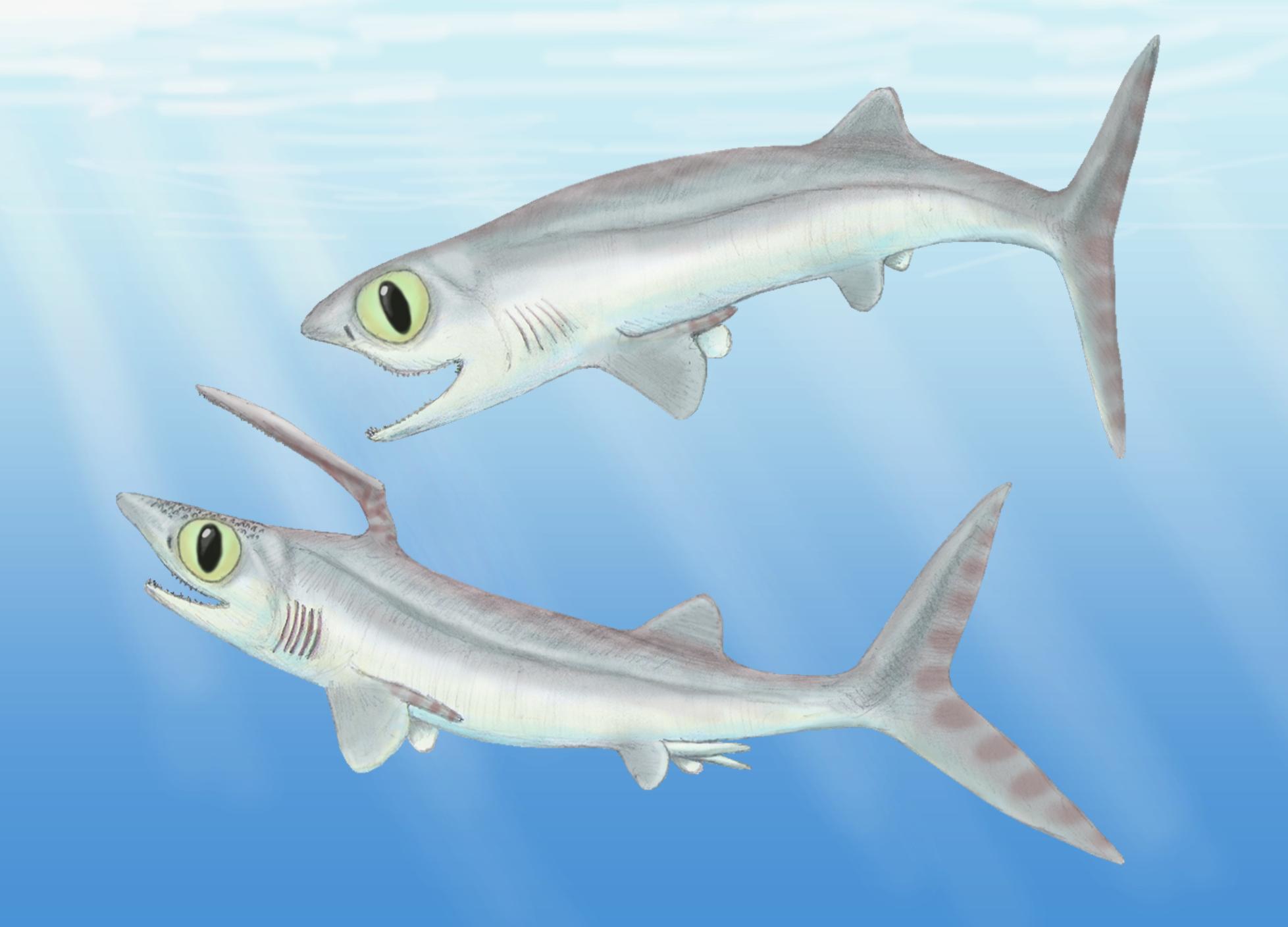|
Falcatidae
Falcatidae is a family of Paleozoic cartilaginous fish belonging to the order Symmoriiformes. Members of this family include '' Falcatus'', a small fish from the Bear Gulch Limestone of Montana. The family first appeared around the start of the Carboniferous, and there is some evidence that they survived well into the early Cretaceous, though its putative Cretaceous members were also argued to be more likely neoselachians. Genera *'' Denaea'' Ginter, M., Hampe., Duffin, C. 2010. Handbook of Paleoichthyology: Volume 3D- Paleozoic Elasmobranchii teeth. Verlag Dr. Freidrich Pfeil *'' Falcatus'' *'' Ozarcus''? *'' Stethacanthulus'' *'' Cosmoselachus'' *'' Cretacladoides''? – possible Early Cretaceous (Valanginian In the geologic timescale, the Valanginian is an age or stage of the Early or Lower Cretaceous. It spans between 137.05 ± 0.2 Ma and 132.6 ± 0.2 Ma (million years ago). The Valanginian Stage succeeds the Berriasian Stage of the Lower Cretac ...) member of the fa ... [...More Info...] [...Related Items...] OR: [Wikipedia] [Google] [Baidu] |
Symmoriiformes
Symmoriiformes is an extinct order of cartilaginous fish. Originally named Symmoriida by Zangerl (1981), the name has since been corrected to Symmoriiformes to avoid confusion with a family. The symmoriiform fossils record begins during the late Devonian, and most had become extinct by the start of the Permian, with the genus '' Dwykaselachus'' from the Artinskian-Kungurian of South Africa being the latest known uncontroversial occurrence. Teeth described from the Valanginian of France and Austria indicate that members of the family Falcatidae might have survived until the Early Cretaceous; however, it has since been proposed that these teeth more likely belonged to neoselachian sharks. Fossil distribution Fossil evidence of Symmoriida have been found at Bear Gulch, Fergus County, Montana, Bethel Quarry, Pike County, Indiana, Kinshozan quarry, Alaska, Gifu Prefecture, Japan, Bashkortostan, Russian Federation and possibly also France. Classification Symmoriiformes were previ ... [...More Info...] [...Related Items...] OR: [Wikipedia] [Google] [Baidu] |
Cretacladoides
''Cretacladoides'' ("cladodont likeness from the Cretaceous") is a genus of chondrichthyan, possibly a falcatid, found in France and Austria. Known solely from teeth, mainly found in the Klausrieglerbach locality of Austria, it consists of two species, ''C. ogiveformis'' and ''C. noricum.'' Assuming a falcatid identity, it is the most recent member of the family, which otherwise became extinct at the end of the Carboniferous. History of discovery The teeth of ''Cretacladoides'' were discovered on a field trip by palaeontologist Alexander Lukeneder in 2012. The limestone in which it was found yielded a diverse tooth assemblage, and was dissolved in acetic acid so they could be extracted. In total, 7 kg of limestone contained roughly 88 diagnosable teeth, including 41 teeth that undoubtedly belonged to elasmobranchs. While some of these had been described in a prior paper, the others were mounted on stubs, coated with gold and scanned with an electron microscope at the Palaeont ... [...More Info...] [...Related Items...] OR: [Wikipedia] [Google] [Baidu] |
Falcatus
''Falcatus'' is an extinct genus of falcatid chondrichthyan which lived during the early Carboniferous Period in Bear Gulch bay in what is now Montana. Description This fish was quite small, only getting to around 25–30 cm or 10-12 inches long. This is about as big as some of the smallest sharks around today, like the pygmy laternshark. ''Falcatus'' was a chondrichthyan known as a "cladodont-toothed stethacanthid holocephalan". The first material known from the genus were the prominent fin spines that curve anteriorly over the head of the animal. When first described in 1883 from the St. Louis Limestone, these remains were given the name ''Physonemus falcatus''. However, in 1985, fossils of a new type of chondrichthyan from Montana were described that displayed a high degree of sexual dimorphism. The same spines that were previously named ''P. falcatus'' were found on one of the morphs, identified as the male due to the presence of valvae.The morphology of ''Falca ... [...More Info...] [...Related Items...] OR: [Wikipedia] [Google] [Baidu] |
Ozarcus
''Ozarcus'' is an extinct genus of symmoriiform cartilaginous fish from the Carboniferous period of Arkansas. The type species, ''Ozarcus mapesae'', was named in 2014 based on cartilaginous skulls from the Serpukhovian-age Fayetteville Formation. The genus is named after the Ozark Mountains (the region of discovery) while the species was named after its discoverer, G. K. Mapes. Discovery and naming The holotype fossil, AMNH FF20544 (formerly labelled as OUZC 5300), was a warped yet three-dimensionally-preserved skull with gill baskets that was discovered by G. K. Mapes. Three additional skulls referrable to ''Ozarcus'' are stored at the AMNH. A partial braincase ( FMNH PF 13242) from the same site, previously been referred to '' Cobelodus'' and described in detail in 2007, was referred to ''Ozarcus'' in 2017. Description ''Ozarcus'' has branchial arches (bones of the gill basket) with unexpected similarities to osteichthyans (bony fish) rather than chondrichthyans (cartilag ... [...More Info...] [...Related Items...] OR: [Wikipedia] [Google] [Baidu] |
Prehistoric Cartilaginous Fish Families
Prehistory, also called pre-literary history, is the period of human history between the first known use of stone tools by hominins million years ago and the beginning of recorded history with the invention of writing systems. The use of symbols, marks, and images appears very early among humans, but the earliest known writing systems appeared years ago. It took thousands of years for writing systems to be widely adopted, with writing having spread to almost all cultures by the 19th century. The end of prehistory therefore came at different times in different places, and the term is less often used in discussing societies where prehistory ended relatively recently. It is based on an old conception of history that without written records there could be no history. The most common conception today is that history is based on evidence, however the concept of prehistory hasn't been completely discarded. In the early Bronze Age, Sumer in Mesopotamia, the Indus Valley Civilis ... [...More Info...] [...Related Items...] OR: [Wikipedia] [Google] [Baidu] |
Valanginian
In the geologic timescale, the Valanginian is an age or stage of the Early or Lower Cretaceous. It spans between 137.05 ± 0.2 Ma and 132.6 ± 0.2 Ma (million years ago). The Valanginian Stage succeeds the Berriasian Stage of the Lower Cretaceous and precedes the Hauterivian Stage of the Lower Cretaceous. Stratigraphic definitions The Valanginian was first described and named by Édouard Desor in 1853. It is named after Valangin, a small town north of Neuchâtel in the Jura Mountains of Switzerland. The base of the Valanginian is at the first appearance of calpionellid species '' Calpionellites darderi'' in the stratigraphic column. A global reference section (a GSSP) had in 2009 not yet been appointed. The top of the Valanginian (the base of the Hauterivian) is at the first appearance of the ammonite genus '' Acanthodiscus''. Subdivision The Valanginian is often subdivided in Lower and Upper substages. The Upper substage begins at the first appearance of ammonite speci ... [...More Info...] [...Related Items...] OR: [Wikipedia] [Google] [Baidu] |
Early Cretaceous
The Early Cretaceous (geochronology, geochronological name) or the Lower Cretaceous (chronostratigraphy, chronostratigraphic name) is the earlier or lower of the two major divisions of the Cretaceous. It is usually considered to stretch from 143.1 Megaannum#SI prefix multipliers, Ma to 100.5 Ma. Geology Proposals for the exact age of the Barremian–Aptian boundary ranged from 126 to 117 Ma until recently (as of 2019), but based on drillholes in Svalbard the defining Anoxic event#Cretaceous, early Aptian Oceanic Anoxic Event 1a (OAE1a) was dated to 123.1±0.3 Ma, limiting the possible range for the boundary to c. 122–121 Ma. There is a possible link between this anoxic event and a series of Early Cretaceous large igneous provinces (LIP). The Ontong Java Plateau, Ontong Java-Manihiki Plateau, Manihiki-Hikurangi Plateau, Hikurangi large igneous province, emplaced in the South Pacific at c. 120 Ma, is by far the largest LIP in Earth's history. The Onto ... [...More Info...] [...Related Items...] OR: [Wikipedia] [Google] [Baidu] |
Cosmoselachus
''Cosmoselachus'' is an extinct genus of symmoriiform chondrichthyan from the Upper Carboniferous ( Mississippian subperiod) aged Fayetteville Shale of Arkansas, United States. The genus contains a single species, ''C. mehlingi'', which is known from a partial specimen that includes the cranium, jaws, gill arches, pectoral fins, and teeth. Discovery and naming The ''Cosmoselachus'' holotype specimen, AMNH FF 20509, was discovered in 1979 in sediments of the Fayetteville Shale near Cove Creek in Searcy County, Arkansas, United States. Since its discovery, the specimen has been damaged and it has experienced pyrite decay while in storage at AMNH. The fossil consists of the nearly complete lower jaws with teeth, a partial upper jaw and basicranium, gill arch elements, cartilage from a partial pectoral girdle, pectoral fins and fin impressions. In 2024, Allison Bronson and others described ''Cosmoselachus mehlingi'' as a new genus and species of shark-like cartilaginous fi ... [...More Info...] [...Related Items...] OR: [Wikipedia] [Google] [Baidu] |
Neoselachii
Elasmobranchii () is a subclass of Chondrichthyes or cartilaginous fish, including modern sharks ( division Selachii), and batomorphs (division Batomorphi, including rays, skates, and sawfish). Members of this subclass are characterised by having five to seven pairs of gill slits opening individually to the exterior, rigid dorsal fins and small placoid scales on the skin. The teeth are in several series; the upper jaw is not fused to the cranium, and the lower jaw is articulated with the upper. The details of this jaw anatomy vary between species, and help distinguish the different elasmobranch clades. The pelvic fins in males are modified to create claspers for the transfer of sperm. There is no swim bladder; instead, these fish maintain buoyancy with large livers rich in oil. The definition of the clade is unclear with respect to fossil chondrichthyans. Some authors consider it as equivalent to Neoselachii (the crown group clade including modern sharks, rays, and all other ... [...More Info...] [...Related Items...] OR: [Wikipedia] [Google] [Baidu] |
Vienna
Vienna ( ; ; ) is the capital city, capital, List of largest cities in Austria, most populous city, and one of Federal states of Austria, nine federal states of Austria. It is Austria's primate city, with just over two million inhabitants. Its larger metropolitan area has a population of nearly 2.9 million, representing nearly one-third of the country's population. Vienna is the Culture of Austria, cultural, Economy of Austria, economic, and Politics of Austria, political center of the country, the List of cities in the European Union by population within city limits, fifth-largest city by population in the European Union, and the most-populous of the List of cities and towns on the river Danube, cities on the river Danube. The city lies on the eastern edge of the Vienna Woods (''Wienerwald''), the northeasternmost foothills of the Alps, that separate Vienna from the more western parts of Austria, at the transition to the Pannonian Basin. It sits on the Danube, and is ... [...More Info...] [...Related Items...] OR: [Wikipedia] [Google] [Baidu] |




